?2017 Porsche 911 Carrera and Carrera S?
Newest 911 Carrera lineup breaks from tradition

The Porsche marque has long been steeped in tradition, particularly within its 911 stable of super sports cars. Yet, even within that traditional scope, the iconic Porsche 911 Carrera offerings have always seemed to up the ante each and every year with some significant evolutionary change or changes that improve not only the car?s looks but its performance capabilities as well – all without sacrificing any of it?s DNA or visual appeal.

The 2017 911 Carrera models prove to be no exception to that rule ? well, sort of. The 911 Carrera is still recognizably a 911 Carrera, but the entry level now incorporates turbocharging to the menu of its least expensive entry level models ? an asset formerly held in abeyance for its higher priced sports vehicles displaying the GT or Turbo badge.

But turbocharging, as important as it is to the revised character of this new Porsche 911 Carrera stable, is certainly not the only significant contribution to the car?s enhanced persona and performance. There are a wealth of advancements that go along with the turbocharging (but without the appearance of any Turbo logos or badging), that boost not only the power and torque range, but the handling prowess of the car as well. In addition to exhibiting impressive enhanced high performance properties, this latest iteration of both the 911 Carrera and 911 Carrera S is also more user friendly as a refined everyday driver, and the base 911 Carrera now produces more torque than the old 911 Carrera S did.

There are new headlights with 4-point running lights, new taillights with 4-point brake lights, and a new 7-inch touch-screen dashboard display. The rear wheels are now .0 5-inches wider; the three-spoke steering wheel design is from the 918 Spyder, with an optional GT Sport steering wheel available. and the rear deck lid now features longitudinal vertical vanes rather than horizontal.
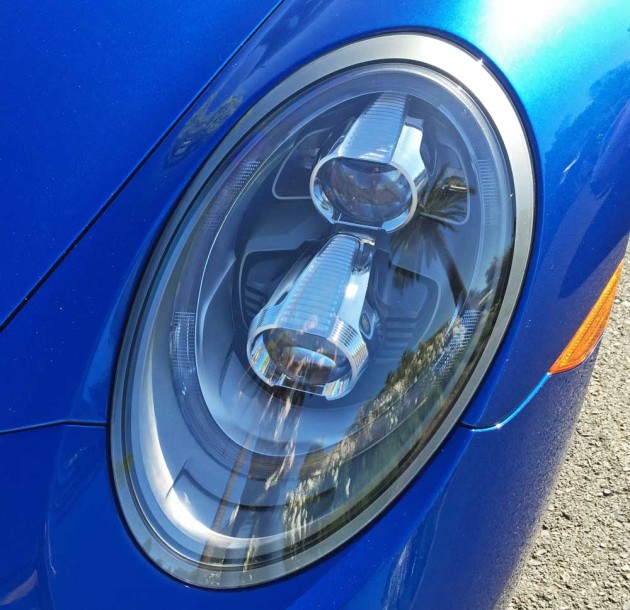
Suspension componentry has also been upgraded, with Porsche Active Suspension Management (PASM) as standard fare, now providing its adjustable ride characteristics to all 911s. It has also received a few minor updates, with the Normal setting moving more to the comfort side of the equation in terms of ride quality, especially for a car with 19- or 20-inch wheels.
Porsche has also tweaked the Sport and Sport+ settings, firming them up for enhanced handling capability. There is definitely a clear distinction between the Normal and Sport suspension settings. Ride height has been dropped by nearly a half inch with the center of gravity lowered for improved stability in cornering (and it lowers an additional half inch with the available Sport Suspension). The new 911 Carrera now offers a front axle lift system as an option priced at $2,590. that raises the front end by 1.5 inches to help clear elevated entryways and lowers back to regular ride height automatically at approximately 37 mph.

The available Sport Chrono feature now includes a mode switch on the steering wheel, with Normal, SPORT, SPORT Plus and Individual settings. A Sport response button engages the optimal gear, with a rev step-up and buildup of charge pressure. There are three exhaust systems: a standard central dual exhaust for the 911 Carrera; a flap system split dual exhaust (quad) for the 911 Carrera S and an optional, multiple flap Sport exhaust with two centrally positioned exhaust tips. The new 911 Carreras also benefit from a weight reduction, resulting from the use of lighter weight materials and engineering improvements, such as a polymer oil pan, with an integrated dry sump and fewer components, turbo size adjustment, virtual gears, Start-Stop plus, and a Coasting function.

Both the Porsche 911 Carrera and healthier 911 Carrera S models draw their motive force from a reduced displacement 3.0-liter, DOHC, 24-valve, twin-turbo flat opposed six cylinder ?Boxer? engine with Direct Fuel Injection. Both benefit from horsepower and torque increases over the old larger displacement engines, while yielding improved fuel economy. The Horsepower (bhp): ratings for the 911 Carrera are 370 @ 6,500 rpm along with 331 pound feet of torque in a range from 1,700-5,000 rpm. The 911 Carrera S produces 50 more horsepower (420) @ 6,500 rpm while developing 368 pound feet of torque (a plus of 37 pound feet) from 1,700-5,000 rpm. The difference in power is the result of the S model’s modified turbocharger compressors, a different exhaust and distinct engine management tuning. Air flow control and intercooling operate on a forced induction concept.
The rear mounted engine gears energy to the rear wheels through either a 7-speed manual transmission with a two-disc clutch for lighter effort, or a 7-speed Porsche Doppelkupplung (PDK) automatic, with modified gear ratios and a new dual-mass flywheel with a centrifugal pendulum. Active rear axle steering is optionally available for Carrera S models, which enhances the driving stability and reduces the turning circle by 1.6 feet. There are also all-wheel drive models that are designated by the numeral 4.

Coded internally as a 991.2, the new 911 Carrera and 911 Carrera S models do not appear dramatically or radically altered from the preceding models. The basic form?s styling remains essentially the same, but has received a refresh in several areas. Among the design highlights: the front and rear fascia display sharper profiles; Active cooling flaps have been incorporated, and in addition to the new headlights and taillights, new exterior door panels appear without grip shells. The new rear decklid grille?s longitudinal air vanes are sprayed high gloss black. There is nothing new beneath the front bonnet or hood ? its configuration remains the same for both Coupes and Cabriolets.
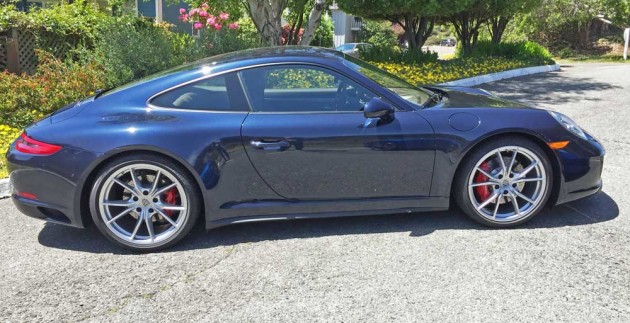
The 2017 Porsche 911 2+2 sports car offerings will consist of: a Carrera and Carrera S coupe; a Carrera and Carrera S Cabriolet; a Carrera 4 and 4S in both Coupe and Cabriolet form; and a Targa 4 and 4S model, with base pricing ranging from $89,400. to $175,900. The price obviously escalates with optional features and equipment, and the $1,050. Destination and Handling charge.

Carrera and Carrera S models may generally be differentiated externally by the exhaust ? as already referenced, standard Carreras feature two centrally positioned dual exhaust tips, while Carrera S models have split dual or quad exhaust tips unless equipped with the active Sport exhaust, in which case, there are centralized dual exhaust outlets. The Sport exhaust emits a pleasing note, but there will be those who feel that the exhaust tone produced by the old normally aspirated flat six motors is more satisfying. You be the judge. In my opinion, the added torque derived from turbocharging is of greater relevance than quibbling over the tone of the exhaust. Engine noises are also pumped into the cabin by sound symposers through a duct without any artificial embellishment.


Pricing starts at $90,395 for the Carrera coupe, with the Carrera S coupe beginning at $104,395. The Cabriolet version of each costs an extra $12,300, while the all-wheel-drive Carrera 4 and 4S add $6,900. 911 Carrera and 911 Carrera S models are on sale now.
For 2017, Porsche Active Suspension Management (PASM) is standard, providing its adjustable ride characteristics to every 911. It has also received some modest updates. The Normal setting has been moved toward the comfort end of the ride quality scale, resulting in a truly impressive ride for a sports car that rides on 19- or 20-inch wheels. The car performs admirably, even on rough road surfaces, delivering a smooth and controlled experience.
At the same time, Porsche has moved the Sport and Sport+ settings even farther over to the firm side of the equation for improved handling. There is definitely no confusing the Normal and Sport suspension settings in the new turbocharged entry level Porsches.
The ride height has been lowered by almost half an inch, lowering the center of gravity for better stability while cornering (it drops an additional half inch with the optional Sport Suspension). The 911 Carreras are now offered with a front axle lift system for an extra $2,590., that raises the front end up by 1.5 inches to help it clear steep entryways. A new PSM Sport mode, with a higher intervention threshold allows for greater yaw and wheelspin while retaining the PSM function if required, with residual ?PSM support? under extreme scenarios for all friction coefficients, with a considerably more noticeable differentiation between functionalities from PSM Active to PSM Sport and, it?s no longer necessary for PSM to be fully deactivated during spirited driving, however, it?s still possible.
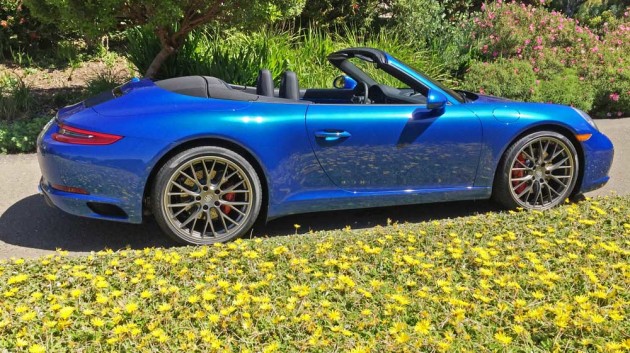
Despite the change from hydraulic to electric power steering, the car delivers a satisfying on-center feeling and instant responsiveness with enough legitimate feedback to provide a lofty level of confidence and control. The newly optional active rear-axle steering on the Carrera S (previously only available on the 911 Turbo and GT3 models) delivers stability and maneuverability that are dramatically enhanced by adding up to 2.8 degrees of rear-wheel steering angle in either the same or opposite direction as the front wheels, dependent upon speed. The turning circle is reduced by nearly one and a half feet, yielding much improved maneuverability. Porsche Torque Vectoring (PTV Plus) further elevates driving dynamics, with increased stability in cornering.
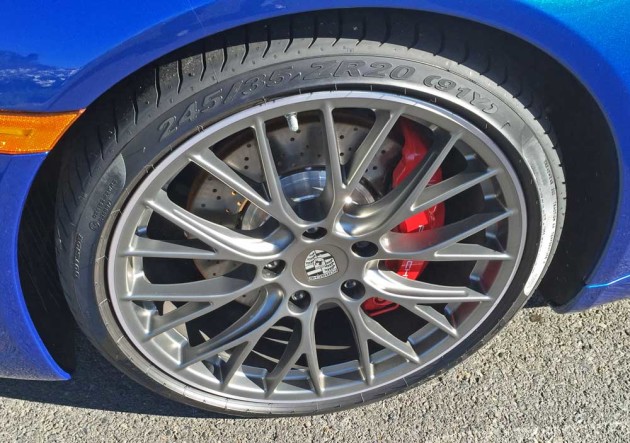
Braking benefits from upgrades such as larger discs and pads on the Carrera S, which are now shared those of the 911 Turbo. The optionally available carbon-ceramic brake system (PCCB) adds even greater whoa power to compensate for the additional go power.
Moving into the cabin, the Porsche Communication Management system has been revised and is now standard on every 911, along with what was the previously an optional rearview camera.
The PCM’s new 7-inch touchscreen now reacts to swiping and pinching motions along with recognizing finger-written number and letter actions in the standard navigation system, which has been upgraded featuring better search capability. Wi-Fi connectivity is also now standard. PCM is Apple CarPlay compatible, while Android Auto is not yet available. There are several connectivity features for infotainment and communication with ports and interfaces, as well as a connect plus module that includes the Porsche Vehicle Tracking System allowing access to vehicle data via a smartphone app for remotely controlling certain vehicle functions.
A lot of button controls are still positioned beneath the PCM screen and running down the center console, but familiarity will readily allow for the quick accomplishment of desired tasks.
Interior fit and finish is typically stellar in true Porsche fashion and the optimum seating position may be achieved through the optional ?14-way? power front seats.
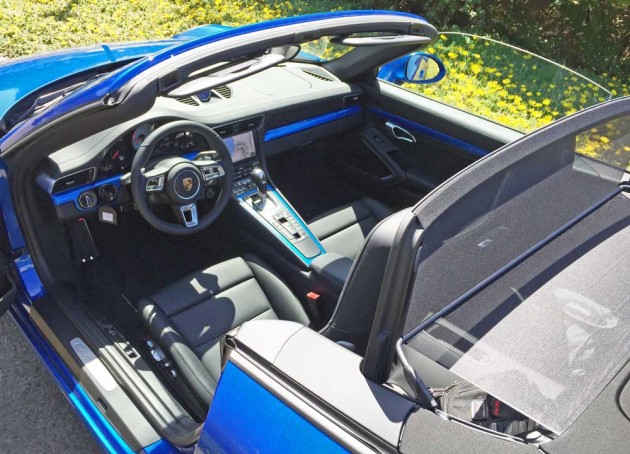
During a Napa Valley and Mendocino wine country press introduction, my driving partner and I were treated to experiencing first a 911 Carrera S Cabriolet with the PDK transmission and a gorgeous Sapphire Blue metallic exterior finish with a Black top and interior. The base price was set at $115,700., while the addition of optional features and equipment along with the Delivery and Handling charge boosted the final count and amount to $144,805. Next up came piloting the 911 Carrera 4S coupe, also with the PDK automatic gearbox, but with the exterior finished in Night Blue metallic and the interior executed in Saddle Brown. Its base price tag read $110,300., which grew to a final tally of $142,255. with its inventory of optional fare and Destination fee.
SUMMARY: The 2017 Porsche 911 Carrera S in either the Coupe or Cabriolet configuration represents the pinnacle of fine, high performance sports cars. Yes, the Turbo and GT badged models do cost more and may go faster, but the new turbocharged entry level Carrera and Carrera S examples deliver exemplary acceleration with the increased torque available over a broad range, and with the steering approaching effortless, especially with either all-wheel drive or with Active rear axle steering.Ride quality is adjustable, but even in the firmest setting, comfort never disappears.

As a fan of open vehicles, the 911 Carrera S Cabriolet was my ride of choice, and as the owner of a restored1957 Porsche Speedster, I have to admit that selling it and replacing it with the new Cabriolet dangerously heightens the level of temptation. The ultimate scenario would be to keep the Speedster and to be able to afford the new Cabriolet as an additional asset, but you can’t have everything, and I?ve grown attached to ?Speedy? as a member of the family. Plus, the Cabriolet?s top is a breeze to open and close, and it is equally gorgeous with the top up or down – an easy operation even on the move.
The 911 Carrera 4S Coupe is almost equally desirable, and to many, it would be the favored choice for those who don?t enjoy the elements. Both are extremely well balanced, totally stable, and a pure joy to drive in either a completely docile manner or in an all-out, ?pedal-to-the metal? spirited fashion. Canyon carving becomes child?s play and is as natural as cruising in Beverly Hills.
In the final analysis, if you possess the financial wherewithal, the purchase of even the base Porsche 911 Carrera represents an ideal way to go for a most rewarding motoring experience, and its 370 horsepower @ 6,500 rpm along with 331 pound feet of torque in a range from 1,700-5,000 rpm is certainly nothing to sneeze at. Ferdinand?s legacy not only lives on ? it continues to prosper and to grow ever better.
[wptabs style=”wpui-light” effect=”slide” mode=”horizontal”]
?[wptabtitle] SPECIFICATIONS: 2017 Porsche 911 Carrera and Carrera SS [/wptabtitle]
?? [wptabcontent]
| Base Price: | $115,700. – Carrera S Cabriolet / $103,400-Carrera 4S Coupe |
| Price as Tested: | $144,805.- Carrera S Cabriolet / $142,255.- Carrera 4S Coupe |
| Engine Type and Size: | 3.0-liter, DOHC, 24-valve, twin-turbo flat six cylinder ?Boxer? with Direct Fuel Injection. |
| Horsepower (bhp): | 370 @ 6,500 rpm-Carrera / 420 Carrera S |
| Torque (ft./ lbs.): | 331 @ 1,700-5,000 rpm-Carrera / 368 Carrera S |
| Transmission: | 7-speed manual or 7-speed Porsche Doppelkupplung (PDK) automatic. |
| Drive Train: | Rear mounted flat opposed (Boxer) six-cylinder engine / Rear Wheel Drive or optional All-Wheel Drive. |
| Suspension: |
Front – Porsche optimized MacPherson type struts?wheels independently suspended by traverse links, longitudinal links and struts, cylindrical coil springs with internal dampers with anti-roll bar and optional front axle lift system. Rear ? Aluminum Multi-link with wheels independently suspended on five links; cylindrical coil springs with coaxial internal dampers and anti-roll bar. Porsche Active Suspension Management (PASM) with electronically controlled dampers; two manually selectable damping programs. |
| Brakes: |
Dual-circuit brake system with separate circuits for front and rear axles; Porsche Stability Management (PSM); vacuum brake booster; brake assistant; electric duo-servo parking brake; autohold function; post-collision braking system. Front axle: four-piston aluminum monobloc brake calipers, perforated and internally ventilated brake discs with 330 mm diameter and 34 mm thickness. Rear axle: four-piston aluminum monobloc brake calipers, perforated and internally ventilated brake discs with 330 mm diameter and 28 mm thickness. |
| Tires: | Pirelli P-Zero 235/40 ZR 19×8.5? Front / 295/35 ZR 19×11.5-Rear-Carrera / Pirelli P-Zero 245/35 ZR20x8.5? Front / 305/30 ZR20x11.5? Rear ? Carrera S mounted on RS Spyder design alloy wheels. |
| Wheelbase: | 96.5 inches |
| Length Overall: | 177.1 inches |
| Width: | 77.9 inches ? with mirrors / 71.2? without. |
| Height: | 50.9 inches ? Carrera / 51.0 ? Carrera S |
| Curb Weight: | 3,153 lbs. M/T ? 3,197 lbs PDK ?Carrera / 3,175 M/T ? 3,219 PDK ? Carrera S |
| Fuel Capacity: | 16.9 gallons |
| EPA Mileage Estimates: | 20 – mpg city / 29 mpg highway M/T ? 22/30 mpg PDK ? Carrera / 20/29 mpg M/T ? 22/28 mpg PDK ? Carrera S. |
| Drag Coefficient: | 0.29 |
| 0 – 60 mph: | 4.4 seconds ? M/T – 4.2 PDK / 4.0 w/launch control ? Carrera / 4.1 sec M/T ? 3.9 sec PDK / 3.7 sec w/ launch control. Top track speed: 183 mph? M/T ? 182 mph-Carrera / 191 mph M/T-Carrera S / 190 mph ?PDK Carrera S. |
?? [/wptabcontent]
[/wptabs]
 Arv Voss is a Northern California based freelance motoring Journalist and member and past officer of several noted Automotive Journalist organizations who contributes regularly to a number of national and international media outlets. He reviews not only cars, trucks and SUVs, but motorcycles and unusual wheeled vehicles as well.
Arv Voss is a Northern California based freelance motoring Journalist and member and past officer of several noted Automotive Journalist organizations who contributes regularly to a number of national and international media outlets. He reviews not only cars, trucks and SUVs, but motorcycles and unusual wheeled vehicles as well.








